Verizon Communications Inc. (NYSE:VZ) Expanding Its Internet Services To Rural Areas
Verizon Communications Inc. (NYSE:VZ) is increasing its access to broadband internet services in rural areas with the introduction of the 4G LTE wireless network. The services mainly target rural areas and will be available in Savannah, GA, Springfield, MO, and Tri Cities, TN/VA/KY. The telecom will expand its internet services to rural areas outside the Fios and 5G Home footprints.
The service will be priced at $60 per month and will offer speeds of up to 50 megabits per second. Verizon wireless phone subscribers will pay a reduced monthly fee of $40. An additional $10 per month will be charged for the router.
“With LTE Home Internet, our most awarded 4G LTE network will provide Internet connectivity for customers in more rural parts of America who may not have access to broadband Internet service” said Frank Boulben, senior vice president of consumer marketing and products.
Why LTE Home Internet?
LTE Home Internet allows users to work from home, enable their kids to attend online classes, and stream their favorite shows on any channel. They will have unlimited data with improved download speed. No tech or tools are needed to set up the router, and new users are enrolled in Verizon’s Smart Setup program, where they have 30 days of free setup support.
In his statement, Boulben said the new service will bring more customers to its broadband Internet service in rural areas in America. He noted that access to the internet is a crucial tool to facilitate remote working and online learning in the wake of the COVID-19 pandemic.
Many rural areas lack access to high-speed internet
Much of rural America still lags with regard to access to high-speed internet. A recent report on access to the internet in the U.S noted that up to 42.8 million people in the country do not have access to broadband internet. According to the report, the average internet speed in rural areas is just over 39Mbps.
Verizon’s 4G LTE network is accessible to 98% of the US population, although there are concerns of signal qualities in some parts.

